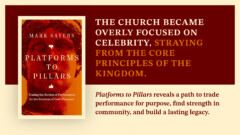I have fond memories of the early days of the Reformed resurgence. These were the days in the early 2000s when so many people were discovering, or rediscovering, the deep and historic truths of the Reformed tradition. Everyone was writing about the five solas and the five points, marveling at how they display God’s glory. Soli deo gloria, indeed.
But it seems to me that somewhere along the way people stopped writing about those truths. They began to assume them in place of celebrating them, to consign them to the background instead of ensuring they remained in the foreground. I understand why this happened—there are only so many books that can be written and so many sermons that can be preached on the same topics. But I also fear that unless we continue to return to these foundational truths, we will inadvertently undermine the very tradition we claim to have become part of.
With this in mind, it was a joy to open Will Dobbie’s From Everlasting to Everlasting: Every Believer’s Biography and find it is a book about the ordo salutis, or the order of salvation. This is another of those topics that was once written about often but is now written about seldom—too seldom, I fear. The ordo salutis is how theologians describe the order by which God saves his people. Beginning with election, it proceeds through calling, regeneration, conversion, justification, reconciliation, sanctification, and perseverance before culminating in glorification. It is a “a stage-by-stage roadmap from eternity past to eternity future. It’s a pathway marked out for us by God consisting of multiple steps, some sequential and some simultaneous. No matter how wild or random life may seem, this is the trail along which He is leading us. It will ultimately guide us home to unimaginable joy.”
Dobbie takes an interesting and helpful approach to the topic by structuring his book as a kind of 30-day devotional. Though there are formally nine steps to the ordo salutis, he increases this to 30 by expanding and subdividing each of them. Hence the topic of election becomes “The God Who Agrees: The Eternal Covenant,” “The God who Knows: Foreknowledge,” and “The God Who Chooses: Election.” Before he discusses calling he considers “The God Who Arranges: Providence” and “The God Who Creates: Conception and Physical Life.” Then, of course, in consistency with Reformed theology, he distinguishes between the external call and the internal call. It’s an effective packaging of familiar topics. The devotional nature ensures it is not just informative but also worshipful.
I grew up within the Reformed tradition and have held to its core doctrines for my entire life. These things are deeply ingrained within my heart and mind. Yet I found From Everlasting to Everlasting a particular pleasure to read, almost like the pleasure of reading a novel that was especially meaningful in my childhood. It was a joy to be reminded of the wonder of how God saves his people and to reaffirm how so much depends upon rightly ordering these steps. It was a joy to see again how God is sovereign in our salvation, how he is glorified from the first step to the last. It was a joy to once again meditate upon one of the unique and uniquely beautiful distinctives of Reformed theology.










